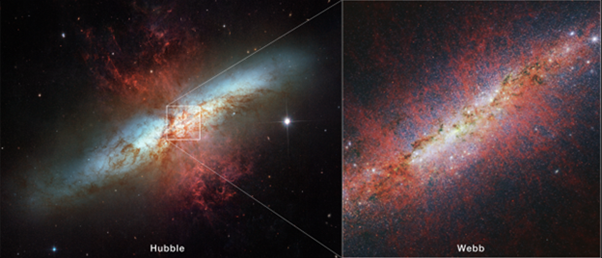NASA’s JWST probes an extreme starburst galaxy

In summary
- An international team of astronomers has used NASA’s James Webb Space Telescope to produce the highest-resolution image of spectacular exploding stars ever seen
- Swinburne's Dr Deanne Fisher led the Australian team, directing the NIRCam (Near-Infrared Camera) instrument
- They revealed that the physics involved in forming new stars is very similar to what shapes clouds in our sky, or waves in the water
An international team of astronomers has used NASA’s James Webb Space Telescope (JWST) to produce the highest-resolution image of spectacular exploding stars ever seen. The Messier 82 (M82) galaxy, located 12 million light-years away in the constellation Ursa Major, is relatively compact in size but hosts a frenzy of star formation activity and is sprouting new stars 10 times faster than the Milky Way galaxy.
Dr Deanne Fisher from Swinburne University of Technology’s Centre of Astrophysics and Supercomputing led the Australian team, directing the JWST’s NIRCam (Near-Infrared Camera) instrument toward the centre of the so-called ‘starburst galaxy’ to obtain a closer look at the conditions that foster the formation of new stars.
This revealed that the physics involved is very similar to what shapes clouds in our sky, or waves in the water.
“The James Webb Space Telescope really opens a new window to studying the gas in galactic winds. We can now see the tiny building blocks of the wind,” Dr Fisher says.
Star formation continues to maintain a sense of mystery because it is shrouded by curtains of dust and gas, creating an obstacle in observing this process. Fortunately, the JWST’s ability to peer in the infrared is an asset in navigating these murky conditions.
The JWST’s NIRCam instrument was well-suited to trace the structure of the galactic wind via emission from sooty chemical molecules known as polycyclic aromatic hydrocarbons (PAHs). PAHs are like very small dust grains that survive in cooler temperatures but are destroyed in hot conditions.
Much to the team’s surprise, the JWST’s view of the PAH emission highlights the galactic wind’s previously unknown fine structure. Depicted as red filaments, the emission extends away from the central region where the heart of star formation is located. Another unanticipated find was the similar structure between the PAH emission and that of hot, ionised gas.
“The PAH emission is an exciting new tool,” explains Dr Fisher. “PAHs are very fragile. You would expect that when supernovae expose the hot inner material from stars, they would obliterate the colder gas.”
“The fact that the PAHs seem to survive out into the wind is a real challenge to theory. It means there is extra physics that we need to understand. We think that similar physics that shapes clouds in the sky, or waves in water, may be important in these extreme environments of galactic winds.”
Finding structure in lively conditions
Looking at M82 in slightly longer infrared wavelengths, clumpy tendrils represented in red can be seen extending above and below the galaxy’s plane. These gaseous streamers are a galactic wind rushing out from the core of the starburst.
One area of focus was understanding how this galactic wind, which is caused by the rapid rate of star formation and subsequent supernovae, is launching and influencing its surrounding environment. By resolving a central section of M82, scientists could examine where the wind originates and gain insight on how hot and cold components interact within the wind.
A vibrant community of stars
NIRCam images of the very centre of the starburst used an instrument mode that prevented the very bright source from overwhelming the detector.
While dark brown tendrils of heavy dust are threaded throughout M82’s glowing white core even in this infrared view, the JWST’s NIRCam has revealed a level of detail that has historically been obscured. Looking closer toward the centre, small specks depicted in green denote concentrated areas of iron, most of which are supernova remnants. Small patches that appear red signify regions where molecular hydrogen is lit up by a nearby young star’s radiation.
Lighting a path forward
The JWST’s observations of M82 in near-infrared light spur further questions about star formation, some of which the team hopes to answer with additional data gathered with the JWST, including that of another starburst galaxy. Two other papers from this team characterising the stellar clusters and correlations among wind components of M82 are almost finalised.
In the near future, the team will have spectroscopic observations of M82 from the JWST ready for their analysis, as well as complementary large-scale images of the galaxy and wind. Spectral data will help astronomers determine accurate ages for the star clusters and provide a sense of timing for how long each phase of star formation lasts in a starburst galaxy environment. On a broader scale, inspecting the activity in galaxies like M82 can deepen astronomers’ understanding of the early universe.
These findings have been accepted for publication in The Astrophysical Journal.
-
Media Enquiries
Related articles
-

- Astronomy
High school students work with Swinburne astronomers on the future of space
Swinburne’s Youth Space Innovation Challenge has inspired over 330 Australian teenagers to pursue a career in STEM.
Friday 26 July 2024 -

- Astronomy
- Science
Swinburne appoints new Director of Innovative Planet Research Institute
Leading geodesy expert, Professor Allison Kealy, has been appointed as the inaugural Director of Swinburne University's Innovative Planet Research Institute.
Monday 22 April 2024 -

- Astronomy
- University
OzGrav 2.0: A ‘new era of astrophysics’ launched at Swinburne
The next phase in the world-leading ARC Centre of Excellence for Gravitational Wave Discovery, dubbed 'OzGrav 2.0', launched this week at Swinburne University of Technology.
Wednesday 17 April 2024 -

- Design
- Astronomy
- Technology
- University
Swinburne ‘Rock Muncher’ takes part in Australian Rover Challenge
A multidisciplinary student team from Swinburne University of Technology competed in the 2024 Australian Rover Challenge held in Adelaide, South Australia.
Thursday 11 April 2024 -
.jpeg/_jcr_content/renditions/cq5dam.web.256.144.jpeg)
- Astronomy
New JWST observations reveal black holes rapidly shut off star formation in massive galaxies
New research showcases new observations from the James Webb Space Telescope that suggest black holes rapidly shut off star-formation in massive galaxies by explosively removing large amounts of gas...
Tuesday 23 April 2024

